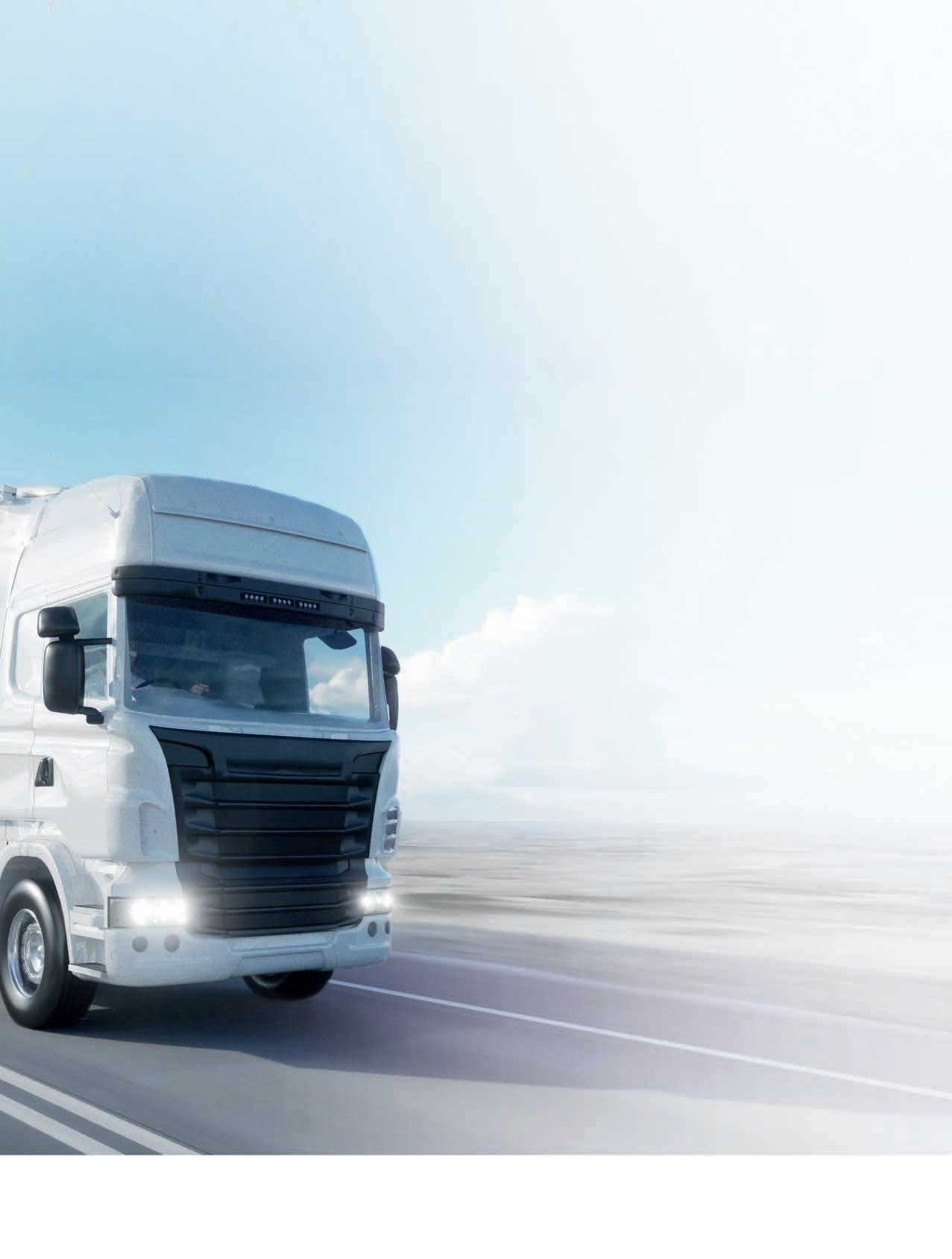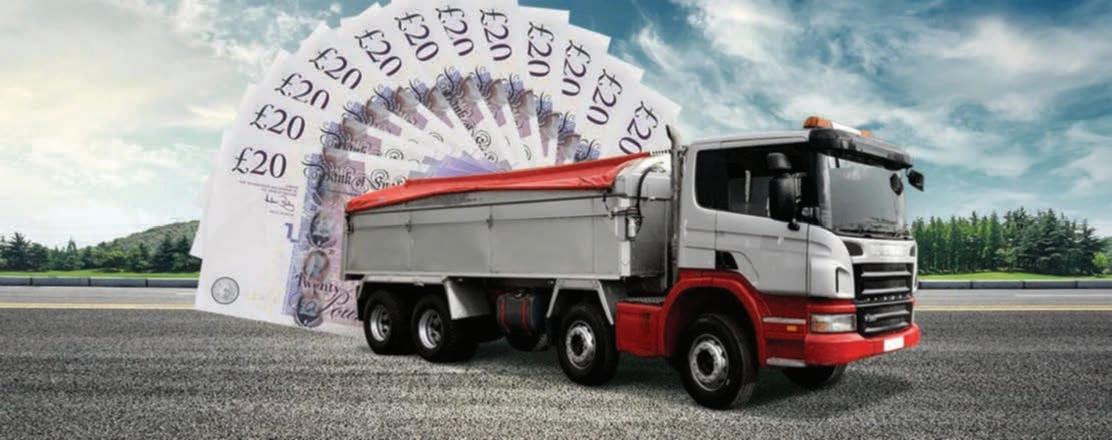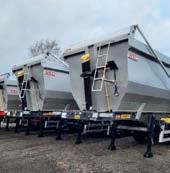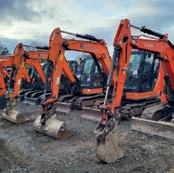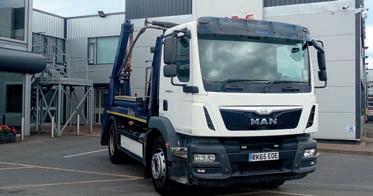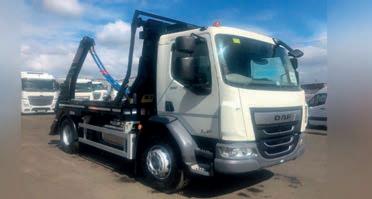Kenyon in Covid collapse
Failure pinned on pandemic p3
Skip firm jobs saved 70 employees transferred p4
Cemex tests CO2 savings
Discharge system on trial p4
XPO protects its name
Trademark action upheld p6
Bootcamp benefits
DfE driver training extended p8
LUCKY ESCAPE: The driver of this HGV had a miraculous escape after the vehicle struck a tree and almost flattened his cab. Surrey police shared the image of the crumpled lorry following the incident in the village of West End, near Woking. However, details of how the accident happened and why the damage to the truck was so severe have yet to be disclosed.

The driver was reported as having been checked at hospital, “but appeared to have escaped serious injury”, according to the force.
Logistics giant bounces back from double disappointment to win contract with fashion retailer
New Look for Wincanton
By Carol Millett and Chris Tindall
Wincanton has replaced Clipper Logistics on a major supply chain contract with fashion retailer New Look.
The move will come as a blow to Clipper – now part of GXO Logistics UK – and comes only four days after Wincanton also secured a five-year extension to its deal with Waitrose.
The three-year contract with New Look begins in July and will see Wincanton manage transport services from the retailer’s distribution centre in Newcastle-underLyme, replenishing stock at 400 stores across the UK and Republic of Ireland.
Wincanton will also support New Look’s click-and-collect delivery services, which have grown from 17% in early 2021 to 31%, and use its Winsight technology to help deliver accurate, real-time visibility on stock location, proof of delivery and optimisation of routes.
However, Wincanton’s successes come during a turbulent period, which has seen it lose two major contracts to Culina Group in the wake of a profit warning last month, triggered by the loss of a deal with HMRC to French firm Sodexo.

In the first of these, Morrisons terminated its £70m-a-year transport contract with Wincanton “with immediate effect” and
handed the entire operation over to Stobart, a year earlier than its original agreed length.
Morrisons confirmed “all logistics transport operations in Stockton, Wakefield, Gadbrook and Willow Green will move to Eddie Stobart, part of the Culina Group.
“The planning operations teams in these sites will transfer back to Morrisons,” it said.
“We will support the TUPE process alongside Eddie Stobart and Wincanton for the transport and planning teams.”

In Wincanton’s financial results for 2020, the 3PL said revenue in its retail grocery division had increased by 26% partly due to the Morrisons deal, as well as new wins with Co-op and Sainsbury’s.
Five days later, Wincanton also lost a major transport contract with cereal giant Weetabix to Culina Group subsidiary Great Bear.
The third-party ambient logistics specialist said the award of the Weetabix contract is a “significant win” for the company and a testament to its customer service levels.
The two-year deal sees a team
from the ambient food haulier operating from the Weetabix site in Burton Latimer. The contract includes factory clearance from Weetabix factories to the Burton Latimer warehouse, and all secondary work in the UK.
n Northern Ireland-based Culina Group subsidiary Morgan McLernon has announced it has landed a major ‘multi-million pound’ contract. Culina has also appointed John Kerrigan to lead the company, in addition to his role as chief executive of Culina subsidiary Fowler Welch.
Sharp ■ Informed ■ Challenging 10.4.23
NEWS
News extra: Bosch p10 Focus: business barometer p12 CV Show preview p14 Viewpoint: AI p16 Gas p18 Telematics p24
INSIDE















Long-established haulier and warehouse firms slide into administration
Pandemic gloom kills off Kenyon
By Chris Tindall
A 90-year-old haulage company in Blackburn has blamed the impact of the pandemic on its collapse into administration.
Kroll Advisory in Manchester was appointed to handle the affairs of Kenyon Road Haulage and Kenyon Warehousing on 20 March and the businesses are now being wound down.
A spokesman for Kroll said: “Michael Lennon and Steven Muncaster of Kroll were appointed as administrators on 20 March 2023.
“Due to the financial position of the entities, both companies ceased to trade with 90 of the 97 road haulage and 18 of the 22 warehousing employees being made redundant.
“The remaining staff have been retained by the administrators to assist with their duties and wind down operations.”
Kenyon Road Haulage was established in 1933 and held an inter-

national licence authorising 82 HGVs running out of three depots in the North West and 12 out of an operating centre in Andover. The family-run firm was taken over in 2016 by new management. Its last available set of accounts, for the year ending 31 July 2021, showed the previous year’s pre-tax profit of £98,000 had converted into a pre-tax loss of £87,000 on an almost £14m turnover.
RECRUITMENT DRIVE: McMurrays Haulage in Accrington has launched a search for administration, customer care and office staff after joining the Palletways network. The family-owned firm is already a member of The Pallet Network and asked anyone affected by the collapse of local business Kenyon Road Haulage and Kenyon Warehousing to get in touch.

Commercial manager Rob Spencer (pictured) said: “We are delighted to have joined forces with Palletways, which is not only positive news for us but for local people looking for jobs in administration and customer care. We are keen to help and support others in the industry.” Added MD David McMurray: “We have a great track record of having staff who stay with us for a long time and we are thoroughly looking forward to adding to our fantastic team.”
Newell & Wright cuts emissions with Volvo FHs
Newell & Wright Group has taken on two new Volvo FH 6x2 tractor units with I-Save after finding other manufacturers could not help the company hit its ‘double figure’ carbon reduction ambitions.

The tractor units feature a Euro-6 compliant D13TC Step E engine, producing 460hp and a peak torque of 2,600Nm.
“With customers temporarily closing due to Covid, the business focused its efforts on its internetbased customers,” a business review said. “Regrettably, this changed the dynamic of its delivery profile from mainly B2B to B2C.”
Driver wage costs also increased by 40% and negotiations with customers to increase rates had taken time to finalise.
Further fuel gains are provided by the I-Shift automated gearbox technology, which monitors speed, weight, road grade and torque demand in order to time each gear shift. The FHs are expected to cover at least 160,000km annually, working five days a week over the next seven years.
Yusen Logistics hit by strike over pay
Warehouse workers at Yusen Logistics downed tools for a week in a row over the company’s pay deal, according to the United Road Transport Union (URTU).
The union said the strike was in relation to a long-running trade dispute, which began in early 2022 when it sought formal recognition with the logistics company at the Grange Park site in Northamptonshire. URTU claimed Yusen implemented a pay deal without its agreement and so it raised a collective grievance demanding an improvement.
Zedify attracts £5m investment for national rollout
Electric cargo bike operator Zedify has secured £5m in funds to roll out its low-carbon service across more of the UK.

The first- and last-mile delivery firm said the funds would enable it to open new locations, including in Manchester and Birmingham, and make itself available to 20% of the population.
Zedify relies on cargo bikes in city centres, where LCVs create congestion and air pollution. It started
in 2018 and its clients include retail brands, parcel carriers and local independent businesses.
Zedify co-founder and chief executive Rob King said: “Zedify’s model delivers significant carbon reduction in the last mile; a fairer system for workers, which counteracts the gig economy; cleaner, safer deliveries that contribute to healthier, more liveable cities; and more choice for consumers about how and when they receive their parcels.”
motortransport.co.uk News MotorTransport 3 10.4.23
South Coast Skips crippled by pandemic and rising costs, but managed to find new roles for staff
Failed waste firm saved 70 jobs
By Chris Tindall
A West Sussex waste management firm that was served with a winding up petition by HM Revenue and Customs was able to transfer all 70 employees to another company before it entered liquidation.
South Coast Skips had been trading for around 20 years and
held a licence for 25 skip trucks, tippers and trailers, running out of an operating centre on the Rudford industrial estate in Arundel.
According to business advisory firm FRP, the company faced significant financial challenges associated with the Covid-19
pandemic, increasing costs and difficult trading conditions.
It meant South Coast Skips accrued liabilities to creditors and was no longer able to meet its financial obligations.
FRP said prior to entering liquidation on 3 March, HMRC presented the company with a
winding up petition, but then a transfer was also secured for all staff to move over to Hoare Construction Group (HCG), which owns the Arundel site.
FRP added that it is now in the process of selling the vehicles, plant and equipment to HCG, which will continue to operate.
Research reveals scale of staffing problem across warehouse sector
Demand for warehouse workers in the UK has rocketed, with the number of online job adverts almost doubling in some areas of the country, according to research.

TOY STORY: JLM Transport has taken delivery of six more New Generation DAF XF 480 6x2 tractor units to help meet the growing needs of its biggest client, Smyths Toys. The new trucks join a mix of 12 New Generation DAF XF 480 and XG 530 tractor units that the Stoke haulier sourced from Asset Alliance last summer. All 18 vehicles – nearly half of the company’s total fleet – are supplied on three-year contract hire deals. They will mainly be used to transport products from Smyths Toys suppliers to the toy retailer’s warehouses in Stoke and Corby, and for outbound deliveries to its stores in the UK and Ireland, as well as for general haulage work.
The North East showed the biggest leap in advertising, with 1,050 ads placed in December 2022, compared to 530 in 2019: a jump of 98.1%.
Indeed Flex, the online staffing app that analysed the data, said the pattern was repeated across the UK, with employers struggling to find staff for warehouse jobs.
Scotland saw a 60% rise in job adverts at the end of 2022 compared to pre-pandemic levels and the South East had the highest
overall number of vacancies, with 6,875 positions advertised online in December 2022 compared to 4,580 in December 2019.
Logistics UK has warned of a crisis in warehousing and the UK Warehousing Association’s chief executive Clare Bottle previously blamed Brexit for causing recruitment problems that were harder to resolve than in driving.
Family-run haulier NLH Logistics slips into administration
A Crewe-based haulage company has entered administration, putting around 27 jobs at risk.
Insolvency practitioners at Dow Schofield Watts in Warrington were appointed to NLH Logistics on 17 March.
The haulier holds a licence authorising 15 HGVs and five trailers running out of a


Marshfield Bank operating centre.
NLH Logistics’ website says the firm had provided pallet services since 1991 with sameday, next-day and international deliveries, and operated a 50,000sq ft warehouse. “NLH is a family-run company based in Cheshire, where we have warehousing facilities for the storage
and distribution of our freight,” it said.
The haulier’s last available set of accounts, for the year ending 31 January 2022, showed that it employed around 27 staff, an increase from 21 in the previous year.
Dow Schofield Watts did not respond to requests for comment from MT
Cemex employee helps slash costs and CO2
Building materials supplier Cemex is trialling a system that could radically cut its cement tankers’ fuel use and emissions.
The system is the brainchild of Nigel Ponton, Cemex UK national fleet engineer, and involves the use of electric cement discharge, which replaces the traditional diesel-powered approach.
Ponton worked with supplier
Gardner Denver to create the system, which is mounted onto the tractor unit and requires a three-phase connection to pressurise the tank and allow discharge to silo. The design means no additional equipment or investment is needed at the customer’s site.
The initial trial carried out at Cemex’s UK operations has demonstrated a potential saving
of over 4,000kg of CO2 in a year, per vehicle, as well as 330 gallons of fuel. Cemex is now looking at rolling it out across its fleet.
Cemex said electric discharge not only cuts emissions, but also enables a faster turnaround and significantly quieter delivery, as well as having the potential to reduce vehicle wear and tear over the long term.
motortransport.co.uk News 4 MotorTransport 10.4.23
Photo: Shutterstock



Logistics giant takes swift legal action against start-up that registered a near-identical name
XPO wins naming rights battle
By Carol Millett
A Nottingham-based company that launched last year with the registered name XPO Logistics Limited has been forced to change its moniker to 14225814 Ltd after logistics giant XPO Logistics Inc complained to Companies House.
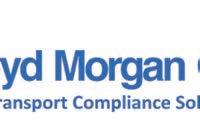

Records show that XPO Logistics Limited was registered at Companies House by Romanian national Argentina Holea on 11 July 2022.
The company’s address is registered at a flat in Nottingham and its business listed by Companies House as providing “other professional, scientific and technical activities, not elsewhere classified”.
Holea is also registered on the


Companies House website as the sole director of Staffline Recurtiment [sic] Limited (14240283) which, according to its Companies House listing, deals in the manufacture of fruit and vegetable juices. This company is not to be confused with Staffline Recruitment Limited (03996086).
Following a complaint from XPO Logistics Inc that Holea’s company name was too similar to its own, Susan Eaves, a company names adjudicator at Companies House, ruled on 17 January this year that the name XPO Logistics Limited was an “offending” name in accordance with section 73(1) of the Companies Act 2006.
The adjudicator also ordered


Topps Tiles renews Pall-Ex deal

Topps Tiles has renewed its home delivery distribution contract with Pall-Ex for a minimum of two years.
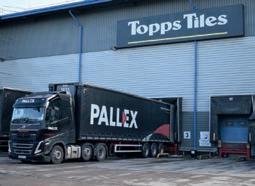
The deal will see the Pall-Ex distribution network support Topps Tiles’ ongoing expansion. The tile retailer, which has 300 stores across the UK, recently acquired online brand Tile Warehouse.
As part of the agreement, Pall-Ex has introduced an implant scheme that sees one of its customer service advisors based at Topps Tiles’ Leicestershire central support office for part of the week.
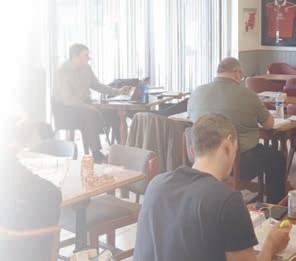
Pall-Ex said this arrangement has already made a “noticeable difference” to customer support and allows both companies to have
a dedicated line of communication on collections and deliveries.
The arrangement will also see Topps Tiles use MyNexus, Pall-Ex’s bespoke freight-tracking software, to track its freight deliveries. MyNexus includes access to What3words, which is integrated into the software, allowing customers to enter precise delivery locations.
XPO Logistics Limited and Holea to pay costs of £800.
Responding, an XPO Logistics Inc spokesperson said: “When it came to XPO’s attention that








another company tried to register a company with the XPO brand name, XPO Logistics Inc took immediate action to protect its trademark.”
EV Cargo targets Asian growth with expanded China presence
EV Cargo is extending its investment in China with the expansion of its office network, the opening of an e-commerce fulfilment centre and a high-profile appointment.
The company has opened branches in Shanghai, Ningbo and Qingdao, adding to its existing footprint in Shenzhen and Hong Kong. The move extends its network of owned offices and warehouses to over 85 locations across 25 countries.
The three new offices, along with their container
freight station (CFS) warehouses, provide directly managed air and sea freight services to and from North and Central China, including consolidation and groupage services.
The new e-commerce fulfilment centre in Hangzhou forms part of its integrated door-to-door service for international brands selling online in China.
Meanwhile, industry veteran Jason Lin has been named vice president of commercial, Greater China.
motortransport.co.uk News 6 MotorTransport 10.4.23
01543 897505 info@lloydmorgangroup.co.uk www.lloydmorgangroup.co.uk BOOK DIRECTLY ONLINE TODAY lloydmorgangroup.co.uk Transport Manager CPC Training From a compliance partner you can trust Excellent Pass Rates 10-day Course Includes Revision Day Includes Online Exam
























































WB Power charges to Hexagon for DAF XFs
WB Power Services has taken on two new 44-tonne DAF XFs from Hexagon Leasing on contract hire.
The company specialises in generator sales, hire and maintenance including diesel generators, hybrid generators and UPS systems and provides critical power services from 13 locations across the UK.
The 6x2 DAF 480 Super Space Cabs are the first it has sourced from Hexagon. “WB Power Services is a brand-new customer to Hexagon Leasing,” said Nick Parker, national accounts and business development manager at Hexagon.
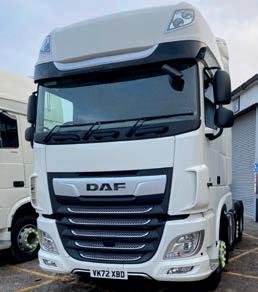
“We look forward to building a long-term partnership with them and are delighted to be their preferred fleet provider of choice.”
DHL to compensate staff for loss of shift premiums
Fears that the Jaguar Land Rover plant on Merseyside could grind to a halt have been averted after DHL agreed to compensate 600 of its logistics and dispatch workers for the loss of their shift premiums.
The dispute arose after the DHL workforce – who are employed on the logistics and dispatch contract
at Halewood supplying the production line with components – learnt they were to lose their shift premiums as a result of an alteration in the workers’ starting time.
DHL will pay the entire workforce a new payment worth 12.5% of earnings in compensation.
Government extends HGV driver training courses to lure new entrants
Vote of confidence for bootcamp programme
By Carol Millett
The government has extended its Skills Bootcamps HGV driver training scheme, with plans to train another 2,160 candidates over the next 12 months to create almost 2,000 new drivers in the logistics sector.

Driver Academy Group (DAG), a consortium led by HGV training specialist HGVC and including Manpower and Logistics UK, has been awarded the lead role in the extension of the scheme by the Department for Education (DfE).
The extended programme went live on 1 April 2023 and is open to any individual holding a driver’s licence for over three years or businesses looking to upskill their existing staff. The training courses are available at 60 locations across the country.
GXO Direct offers ‘easy warehousing’
Contract logistics giant GXO is moving into the UK’s shared warehousing sector with the launch of GXO Direct.

The move sees GXO and Clipper Logistics, which was acquired by GXO last year, combine their flexible, shared warehousing space, cutting-edge
technology and services to create one of the UK’s largest sharedspace offerings.
GXO Direct is also promising to help companies expand sales into new channels, including e-commerce, achieve economies of scale, reduce costs, minimise environmental impact and deliver a better customer experience.
The service is targeting customers ranging from large established businesses with evolving needs, to smaller brands that are either just starting out or rapidly expanding, that don’t need a dedicated warehouse of their own but want a premium service.
Customers will have access to GXO’s experience and resources, as well as its management information systems and software.
Under the new contract, DAG will deliver 1,300 partially funded courses. These offer employers a 70% contribution to HGV driver training through the DfE funding. HGVC will also deliver 860 fully funded courses, aimed at individual candidates.
DAG’s 2023/24 programme will
focus primarily on the novice driver training pathways, helping them gain their Category C licence, a Category C+E licence or helping those with a Category C licence upgrade to a Category C+E.
Both candidates and businesses can apply to the scheme at www.hgv.academy
Kinaxia counts on eastern promise with revised regional structure
Kinaxia Logistics has created the new role of regional distribution director for the East of England.
Ian Dinmore has been promoted from MD of Cammack to the new position, which sees him responsible for overseeing a regional area that covers the group’s NC Cammack & Son business in Essex and Foulger Transport in Norfolk. Cammack and Foulger employ a total of 170 staff, operate 100 vehicles and have a combined turnover of over £21m.
Dinmore joined Kinaxia from Leman in 2019 as Cammack’s operations manager. He began his career in the sector in 2004 and worked at FedEx before joining MARU International, which was taken over by Leman in 2017.
Kinaxia chief executive Simon Hobbs said:
“Combining both businesses under Ian’s leadership will further assist Kinaxia Logistics with our operational standardisation and collaboration.”
motortransport.co.uk News 8 MotorTransport 10.4.23






















































Tech firm bets on hydrogen as the future fuel source of choice for HGVs
Building a range of hydrogen options
Bosch does not envisage hydrogen ICEs being limited to low or medium horsepowers, as was the case when the first spark-ignition methane engines were launched.
“The projects afloat today with hydrogen port fuel injection and direct injection mean that power output will not be a constraining factor,” predicted Srinivasan. “I don’t think there will be a power limitation; on the contrary we will not have the heat dissipation issues that we have with fuel cells, where efficiency drops off at high loads.”
While Srinivasan was guarded about which truck OEMs Bosch is partnering with (except for Qingling), he did say that the company is “working with all the major US, European and Chinese manufacturers”.
It might be possible to convert an existing methane engine to run on hydrogen, but Srinivasan said the performance and efficiency would not be the same as a purpose-built hydrogen ICE.
Hydrogen should also have a role in storing energy made from surplus renewable electricity when supply exceeds demand.
Global technology giant Bosch is developing a range of battery electric and hydrogen powertrains for commercial vehicles, and it foresees hydrogen internal combustion engines (ICEs) playing a vital role in decarbonising heavy-duty trucks.
The firm believes that battery electric and hydrogen fuel cells are well suited to light and medium commercial vehicles. It has already launched its compact self-contained eAxle unit combining an 800V electric motor, power electronics and transmission mounted on the vehicle’s axle in ratings up to 300kW for 7.5 tonne trucks.
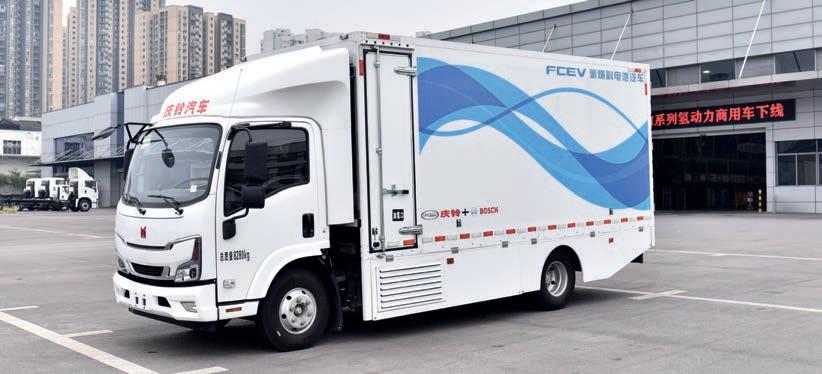
Bosch is also road testing 70 18-tonne Qingling trucks in China. They are powered by hydrogen fuel cells and batteries with a range of 500km, using a tank holding 11.7kg of hydrogen.
The company predicts oneeighth of all new commercial vehicles worldwide will be powered by fuel cells by 2030. With this in mind, it is building a fuel cell factory in Chongqing in western China’s “hydrogen valley”. The first phase, including an R&D and testing centre and manufacturing plant, is expected to start operation at the end of May.
Arun Srinivasan is head of Mobility Solutions at Bosch UK and has responsibility for its UK business, as well as its global business with Jaguar Land Rover. He said the company is “committed to having the best technology available for carbon-neutral solutions”.

“Electrification is clearly going to play a part and we are already seeing garbage trucks and city buses going electric,” he said. “They come with the challenge of how often they need charging.
“We have a clear intent to play in the hydrogen space and we have done a significant amount of work in our Hamburg plant, which was a former diesel and gasoline plant but now makes hydrogen fuel cells.
“That will get the green light later this year to start producing these stacks. We believe in hydrogen as an energy vector.”
Powering heavy trucks
While battery electric is seen as the best solution for light commercials up to 7.5 tonnes, and fuel cells work well for medium-duty trucks up to 26 tonnes running short mileages, there remain technical hurdles to overcome for longdistance heavy trucks.
“Fuel cells are very good in terms of efficiency at the lower end of the power segment,” said Srinivasan. “But if you look at the heavy-duty, long-haul segment there is an issue with efficiencies and temperature management.
“There is a need for a solution for heavy-duty trucks and this comes in the form of a hydrogen engine, where we use hydrogen as fuel directly in the combustion
chamber. Any resulting exhaust is then treated with an SCR system, as we do today with diesel trucks.”
While this would not be a completely zero-emissions engine, Srinivasan said there would be “negligible tail-pipe emissions”.
“That is a technology we are working on and there are already 100 projects within Bosch in that space,” he said. “That is for both on- and off-highway sectors, because you cannot electrify [agricultural] tractors in remote parts of the world.”
Inevitably, fuel cells will not be suitable for all heavy-duty truck applications. There is a large overlap between hydrogen fuel cells and ICEs in the Bosch map of which technology will work for which segment of road freight transport.
Despite the lower energy density of hydrogen compared with diesel,
Government input
“At the moment we are paying companies to switch off wind turbines because we cannot store electricity,” argued Srinivasan. “Why wouldn’t we be able to produce hydrogen? I’m glad we now have someone in the government in charge of hydrogen from a policy and strategy perspective [hydrogen champion Jane Toogood]. She will bring together the entire hydrogen eco-system.
“It is time to make those big bets for the country; transportation is a pioneer in many ways. I have shared with Jane some magazine articles from 1959 on the transport sector and she was fascinated to see our history and heritage.
“It will be a pity if we don’t do the sector justice in this future technology. The technology works and we just need the go-ahead from government to get on and do it.
“Other countries are marching ahead and we need a national commitment. Bosch will be part of it – we will have been in the UK for 125 years this year and we are here for the long run.”
■ For all the latest news and information dedicated to the decarbonisation of the commercial vehicle and road freight sector, check out our sister website FreightCarbonZero.com

motortransport.co.uk News extra: Bosch 10 MotorTransport 10.4.23
ON TEST: Bosch is road testing 70 18-tonne Qingling trucks powered by hydrogen fuel cells and batteries
ICE ADVOCATE: Bosch UK head of Mobility Solutions Arun Srinivasan



UK economy expected to shrink due to several factors including high inflation and rising oil prices
UK recession cancelled – maybe
Gross domestic product
After achieving one of Europe’s stronger gross domestic product (GDP) growth rates in 2022 – confirmed last month as 4.1% – the UK economy is likely to contract this year.
This downbeat view comes from the Organisation for Economic Co-operation and Development (OECD) in its latest Economic Outlook, published in November. The OECD projects that UK GDP will shrink by 0.4% in 2023, one of only a handful of European economies expected to contract. Most of these, such as Germany, Finland and Latvia, are suffering the effects of Russian aggression in Ukraine, either because of broken trading links or former dependency on Russian energy.
The OECD says UK growth will be suppressed by weak consumer consumption due to high living costs such as food and energy, compounded by declining real wages. The organisation expects GDP across the euro area to grow by 0.5%, well below its forecast global average of 2.2%. The predicted star performers are India (5.7%) and China (4.6%).
A less gloomy – and more recent – view of the UK’s prospects came last month from the Office for Budget Responsibility (OBR), taking account of the Chancellor’s budget measures. The OBR reckons UK GDP will shrink by only 0.2% this year. The first significant indicator comes on 12 May, when Q1’s GDP figures are due.
The Bank of England said last month that it is expecting to see GDP contract by just 0.1% in Q1, followed by a little economic growth in Q2. That would avoid two successive quarters of contraction, thus side-stepping a recession.
Inflation
Consumer price index (CPI) inflation jumped unexpectedly from 10.1% in January to 10.4% in February, ending the downward trend since last October’s peak of 11.1%. Energy costs remain the biggest contributor to inflation, although the Office for National Statistics (ONS) notes that food price inflation of 18.2% in the year to February is the largest hike
in food costs for 45 years. February’s surprise inflation uptick prompted the Bank of England to raise its base rate from 4.0% to 4.25% last month.
The bank expects the rising price of goods to moderate quite quickly, whereas inflation in the services sector will be more persistent. The clues are in February’s data: goods inflation has been broadly flat for the last three months at just over 13%, whereas services sector inflation rose from 6.0% in January to 6.6% in February. This is because recent sharp rises in pay settlements are particularly impactful in the services sector, where labour costs are dominant.
The bank expects CPI inflation to be down to around 7.0% by June. The OBR reckons it will subside to 2.9% by the end of this year.
Earnings
Average regular pay (excluding bonuses) during the three months to the end of January was 6.5% up on the same period a year ago. But the ONS says this equates to a 2.4% cut in real terms after inflation.
The overall figure of 6.5% masks two very different scenarios. Pay settlements in the private sector appear to have peaked at 7.3% last autumn, falling back to 7.0% in the latest data, which cover the three months to the end of January. But employees in the public sector are lagging behind, in both the scale and timing of their pay settlements. The ONS data show their average pay settlement is still rising, with the latest figure at 4.8%.
Fuel and oil
The Chancellor’s decision in last month’s budget to continue the 5ppl fuel duty cut until 23 March 2024 meant that the feared diesel price hike did not occur. Nevertheless, despite extending the duty cut and no inflationlinked increases since 2011, the UK’s diesel duty of 52.95ppl remains the highest in Europe.
EU tax rules set a minimum diesel duty of 0.33€/litre (29ppl) and several eastern European countries, like Poland, Romania and Hungary, have chosen to stay close to this minimum.
The Brent oil price fell sharply from around $83 to $73/barrel
CPI INFLATION: GOODS AND SERVICES
GDP: ANNUAL GROWTH RATE
in mid-March, triggered by fears of economic contagion from US and Swiss bank collapses. Oil clawed its way back up to $79 by the month end, leaving the March average as $78. Most hauliers taking full loads of bulk diesel probably paid an average of 117ppl to 121ppl in March, the
lowest for just over a year. But April’s average is already shaping up to be higher, because Saudi Arabia and several other oilproducing countries last week announced new output cuts, which immediately drove the Brent price back up to around $84/barrel. n
12 MotorTransport 10.4.23 motortransport.co.uk
Business barometer
GROWTH (REGULAR PAY) 0.0 1.0 2.0 3.0 4.0 5.0 6.0 7.0 8.0 9.0 10.0 Annual earnings growth % Three months to... Jun 22Jul 22Aug 22Sep 22Oct 22Nov 22Dec 22Jan 23 Private sector Public sector -1.0% -0.5% 0.0% 0.5% 1.0% 1.5% 2.0% 2.5% 3.0% 3.5% 4.0% 4.5% Change on previous year % Euro areaFrance Germany ItalyJapanUKUSA 2022 2023 (OECD forecast) 0.0 2.0 4.0 6.0 8.0 10.0 12.0 14.0 16.0 CPI annual inf lat ion rate % Aug 22Sep 22Oct 22Nov 22Dec 22Jan 23Feb 23 Goods Services
EARNINGS

Technology will take centre stage for exhibitors at this year’s CV Show
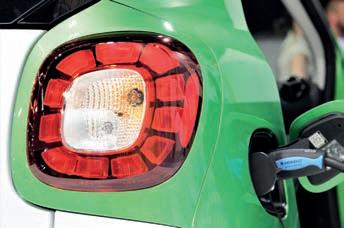
VisionTrack takes AI route to safety

Road safety will take centre stage on VisionTrack’s stand at the CV Show as it showcases a growing range of industry-leading AI video telematics solutions.
The company will be using the event to introduce an AI detection camera for vulnerable road users (VRUs) as well as demo its AI-powered post-analysis software, NARA, launched earlier this year.
“We are embracing the latest advances in machine learning and computer vision to develop innovative AI video telematics solutions for the road transport sector,” explained Richard Lane, commercial director of VisionTrack.
“The CV Show will provide us with a platform to share our technology expertise and provide guidance on how best to improve road safety and eliminate fleet risk.”
The AI-powered VRU detection camera will be able to identify
pedestrians, cyclists, motorcyclists and people on scooters while disregarding street furniture. Footage will automatically be displayed on an in-cab monitor and supplemented with an audible, spoken warning with the precise location of nearby VRUs in relation to the vehicle. This will keep the driver more engaged by providing accurate and useful information.
Meanwhile, operators will have the opportunity to check out AI-powered post-analysis solution NARA. This cloud-based software is revolutionising how vehicle camera footage is assessed and helping vehicle operators to save time, costs and most importantly lives, by providing proactive risk intervention and accurate incident validation.
Fleet Operations will demonstrate the power of its innovative new driver companion app – combining an extensive suite of vehicle and safety management tools – at this year’s CV Show.
The UK’s largest independent fleet and mobility management specialist has launched the latest addition to the MOVE software platform to give drivers everything they need to order and run their vehicles from the palm of their hands.
Sustainability specialists will also be on hand to offer advice to van fleets on how to make the electric transition in the most costeffective way and to signpost the most appropriate strategies to optimise total cost of ownership.
“Our new app, which we’ve tagged as the only passenger you will ever need, digitally transforms everyday tasks by providing key vehicle information alongside intuitive, automated processes to make working lives safer, easier and more productive,” said Fleet Operations sales and marketing director Jayne Pett.
Teletrac Navman demonstrates how to make EV conversion add up
Global market leader in telematics technology, Teletrac Navman, will be at this year’s CV Show to discuss the upcoming migration from internal combustion engines to electric vehicles and showcase technology that facilitates fleet operators in the transition.
On show will be Teletrac Navman’s EV Readiness Tool, which uses smart algorithms to assess trip data across any fleet to determine which vehicles are suitable to switch.
It also provides fleet operators with a structured and cost-effective conversion plan with additional
insight into total cost of ownership, tax breaks, fuel savings, optimum locations for chargers, and environmental impact.
Barney Goffer, UK product manager at Teletrac Navman UK said: “Managing rising fuel costs is the biggest challenge facing fleet operators today, according to 39% of respondents in our latest research study. “Couple this with the growing global response to reduce all forms of carbon emissions and it is clear that the transition to EV is gaining momentum globally.”
TruTac streamlines fleet management and compliance with new modules
TruTac will be presenting new modules and product features within its range of fleet management and compliance control software at this year’s CV Show. For the first time it will share a stand with parent company Microlise.
Headlining the new modules is TruFleet Workshop, designed to improve asset management and maintenance planning. The tool enables TruFleet users to upgrade to a range of workshop-focused features,
with the facility to create bespoke templates for all vehicle needs including inspections, repairs, servicing, annual tests and associated costs.
Visitors will be able to view the Microlise tracking system within TruTac’s TruControl tachograph analysis and reporting software. Following a major new release and product update, users can now see their vehicles’ location and associated information within the platform, giving
them an instant overview of all their fleet’s data in one single place.
Also on show will be TruDocuments Premium, which allows customers to make the likes of policies, handbooks, certificates, and other vital literature directly available to drivers via the TruTac app. When published, the documents are instantly available to all employees with access to the app, or only to a portion of the workforce of the operator’s choosing.
motortransport.co.uk CV Show 14 MotorTransport 10.4.23
Fleet Operations makes MOVE to integrated future



















A taxing matter of debt and GDP
The death of Nigel Lawson and the debate about his legacy as Margaret Thatcher’s tax-cutting Chancellor of the late 1980s has led to comparisons between the Conservative governments of now and then.
Steve Hobson Editor Motor Transport
The UK’s record post-Covid-19 national debt would make you think we are in an era of high tax and low public spending as we try to repay that £2.5 trillion public sector net debt. That amount represents 99% of gross domestic product (GDP), a debt-to-GDP ratio last seen in the early 1960s.
Yes, the last Budget saw corporation tax rise from 19% to 25% – but Lawson only reduced it from 52% to 35%. When it comes to personal income tax, Lawson looks like a tax and spend left winger compared with the current incumbent of no 11.
Lawson made headlines in 1988 when he cut standard income tax from 29p to 25p in the pound and cut the top rate to 40p. However, the standard rate is currently just 20p, the higher rate is still 40p and the top rate of 45p is only payable on annual income over £150,000.
Tax matters because the more money the state collects to do all the things we expect it to do, the less there is to spend on goods and services at a time when prices are rising faster than wages.
So two cheers as the UK now looks like it will avoid the deep and prolonged slowdown that had been predicted last year, but GDP is still expected to shrink between 0.2% and 0.4% this year. Maybe that will finally end talk of a driver shortage and 15% wage increases.
Putting AI to good use in haulage
Richard Kent President of global sales, VisionTrack

Artificial intelligence (AI) is having an ever-greater influence on our everyday lives, and has a growing and key role in how commercial vehicle operators approach road safety and reduce fleet risk. AI video telematics – using vehicle cameras connected to a cloud-based platform – has massive potential within the road transport sector.
In the broadest sense, AI is about using machines to perform tasks that would typically have required some form of human intervention and demonstrate behaviours associated with human intelligence. There are two types of technology – edge- and cloud-based –which will see AI become increasingly embedded in video telematics hardware and software. For edge-based solutions the processing takes place close to the data source, such as a connected camera device, to provide real-time insight, whereas cloud-based solutions collect and process information in a centralised data centre for powerful post analysis.
AI vehicle cameras, using advanced driver assist system (ADAS), driver status monitoring (DSM) and blind spot detection (BSD) technologies, have been around for several years. They are enabling road transport operators to maintain safety levels for both their drivers and other road users by automatically monitoring hazards on the road as well as high-risk behaviours and distractions. This makes it possible to provide real-time feedback straight to the driver, but there is also the added benefit of gaining valuable insight into fleet risk.
These intelligent vehicle camera systems have proven safety benefits but they are still limited by the processing capacity of the device, so it is in the cloud where the true value of AI will be realised. The
challenge for many road transport operators is simply the volume of video and data that is captured.
Due to the size and weight of commercial fleet vehicles, the g-force settings for cameras are highly sensitive to ensure collisions are picked up. As a result, triggered video can exceed hundreds per day, many of which are false positives caused by speed bumps, potholes and other harsh driving events.
Effective analysis is crucial for any video telematics solution, yet a manual process rarely provides the level of accuracy or responsiveness needed to take full advantage. Cloud-based AI cuts through the noise, so operators are presented with the information that requires immediate attention.
The latest advances in computer vision can be used to review huge amounts of data, identifying different types of vehicles, cyclists and pedestrians to achieve accurate incident validation within seconds. This added layer of analysis enables emergency assistance to be quickly summoned in the event of a suspected injury.
Meanwhile, the ability to detect, monitor and analyse collisions, near misses and harsh driving events in seconds, without human intervention, supports data-driven safety decision-making and problemsolving. Using insight into driver behaviour, road transport operators can achieve proactive risk intervention that makes it possible to improve driver performance, reduce collisions and, most importantly, save lives.
Got something to say?
If you would like to contribute to MT’s Viewpoint, email steve.hobson@roadtransport.com
The newspaper for transport operators
To contact us: Tel: 020 8912 +4 digits or email: name.surname@roadtransport.com
Editor Steve Hobson 2161
Head of content Tim Wallace 2158
Events and projects editor Hayley Tayler 2165
Group production manager Isabel Burton
Senior display sales executive Barnaby Goodman-Smith 2128
Event sales Tim George 0755 7677758
Classified and recruitment advertising rtmclassified@roadtransport.com
Sales director Emma Rowland 07780 604075
Divisional director Vic Bunby 2121
MT Awards Katy Moyle 2152
Managing director Andy Salter 2171

Editorial office Road Transport Media, First Floor, Chancery House, St Nicholas Way, Sutton, Surrey SM1 1JB 020 8912 2170
Free copies MT is available free to specified licensed operators under the publisher’s terms of control. For details, email mtsccqueries@roadtransport.com, or call 01772 426705
Subscriptions
RoadTransport@abacusemedia.zendesk.com 020 8955 7034


Motor Transport Subscriptions, Abacus, 107-111 Fleet Street, London EC4A 2AB
Rates UK £156/year. Cheques made payable to Motor Transport. Apply online at mtssubs.com
Registered at the Post Office as a newspaper
Published by DVV Media International Ltd © 2023 DVV Media International Ltd


ISSN 0027-206 X

motortransport.co.uk Viewpoint 16 MotorTransport 10.4.23











































































The case for gaspowered trucks
With the government set to ban the sale of all new gas-powered trucks from 2040, why are hauliers still investing in them today?
Carol
Millett
As the race to decarbonise diesel-powered fleets picks up pace, how safe a bet are gaspowered trucks when cleaner technologies are starting to jockey for position?
With hydrogen, catenary and batterypowered trucks starting to gain ground and capable of hurdling over the government’s 2040 ban on the sale of new non-zero emissions trucks, could hauliers be in danger of backing the wrong technological horse?
There are currently almost 3,000 gas-powered trucks on the UK’s roads, of which around two thirds are powered by liquid natural gas (LNG) and a third fuelled by compressed natural gas (CNG).

James Westcott, chief commercial officer at bio-LNG and bio-CNG supplier Gasrec, says those numbers are continuing to rise steadily, despite the recent spike in gas prices as a result of the Ukraine war and the government’s deadline to ban sales of new fossil-fuelled 26-tonners from 2035, with the ban extending to heavier vehicles from 2040.

Gasrec’s refuelling station network has grown steadily and despite a stutter last year, thanks to the fuel crisis, Westcott says that demand is now back on track, with gas prices falling this year to their lowest levels since the summer of 2021.
investigates.
“We’re certainly seeing a lot of activity at the moment for deployment later this year,” he adds confidently.
To that end, the company, which operates a network of 20 refuelling stations, is continuing its strategy of opening three gas refuelling stations a year, including a number of much larger public-access stations similar to its DIRFT facility.
Meeting increasing demand
Philip Fjeld, chief executive of fuel provider CNG Fuels, is also confident demand will continue to grow, particularly as the price of gas continues to fall.
The company currently operates 10 large public-access stations providing bio-CNG. It plans to double that number to 20 by 2024, with between 30 and 40 up and running by 2026.
Fjeld declares: “There’s never been greater interest in running trucks on biomethane. The number of new customers coming on board this year has never been greater, the number of trials we’re running with demo vehicles has never been greater.”
But for how long will fuel suppliers commit to sourcing biomethane for a technology set to be replaced by net-zero alternatives in just 17 years?
Fjeld insists CNG Fuels is committed to its customers for the long term. He says: “Biomethane will be a very, very important fuel for decades to come and we’ll continue to provide that. But we’re completely fuel agnostic, so if in the future our customers want rapid recharging for battery electric vehicles, or hydrogen, or a combination of both, then we will also provide that.”
motortransport.co.uk Gas 18 MotorTransport 10.4.23
Photo: Matt Howell
BACK ON TRACK: James Westcott, chief commercial officer at Gasrec, says the demand for gas has returned
➜ 20
GROWTH STRATEGY: John Lewis Partnership runs a fleet of 400 bio-CNGpowered trucks and is planning to invest in more


















Westcott says Gasrec is also committed to providing LNG and CNG for its customers post-2040 and, like CNG Fuels, is future proofing its network to support customers on their net zero journey.
“Things will change at some point and it’s important that our sites are in the right locations and are adaptable to future developments,” he adds.
Cutting costs and emissions
Justin Laney, fleet manager at John Lewis Partnership (JLP), is another vocal supporter of gas-powered fleets. He currently oversees a fleet of 400 mainly Scania P series trucks powered by bio-CNG. By 2028 the company plans to expand this gas-powered fleet to 550.

JLP’s gas trucks will not only save 400,000 tonnes of CO2 emissions by 2030, but will also deliver significant savings on operating costs. Bio-CNG is still coming in considerably cheaper than diesel, now prices have settled since the fuel crisis peaked last year.
Laney sees gas trucks as a vital stepping stone on the way to net zero, allowing companies to cut emissions significantly whilst waiting for the arrival of a viable, affordable net-zero alternative.
“We are looking at a 10 to 15 year roll-out on battery-, catenary- and hydrogen-powered trucks. So biofuels have a really important role to play in that interim period, which is at least two whole vehicle lives,” he explains.
David Landy, head of fleet at parcel delivery giant Evri, is another keen proponent of gas trucks who remains confident they’re a sensible investment.
Evri currently boasts a fleet of 160 Iveco Stralis and S-WAY CNG-fuelled trucks, which it estimates saves 24,000 tonnes of CO2 annually.

Landy says: “We certainly don’t see gas trucks as a long-term solution but we do see it as a way of cutting emissions for now, until something better comes along that actually works for us. Right now manufacturers have a lot of catching up to do to get these technologies to that stage.”
Another factor feeding demand for gas-powered trucks are the environmental, social and governance (ESG) agendas of many large operators and PLCs, says Fjeld, which have set ambitious environmental targets, often exceeding those of the government.
“We have customers with a trajectory to be 50% decarbonised by 2025 and 100% by 2030. They can’t wait for some magic bullet to arrive in the future. They have
WHAT PRICE RESIDUAL VALUE?
The residual value (RV) of gas-powered trucks has yet to be established, since few have reached the end of their first life.
John Lewis Partnership (JLP) plans to sell its first two demonstrators this year, and fleet manager Justin Laney is predicting their RV could match that of the retailer’s diesel trucks.
He says: “I’d expect to get a decent residual value because there’s such a limited number of secondhand ones on the market.”
He believes the RV could rise further as 2040 approaches, particularly if there aren’t sufficient government incentives to switch to new technologies.
“There’ll be a lot of operators who will leave it until the last minute, so it could be that gas and diesel trucks actually attract a premium going into 2040 from people wanting to run them for as long as they can after that deadline,” Laney predicts.
Fjeld believes demand for second-hand CNGpowered trucks will be significant. “Around 80 to 90% of CNG-powered trucks are owned by the 3PLS, such as the supermarkets and Amazon. We’re told there’s a very long list of fleets wanting to buy them, so I’d expect the second-hand value to be very attractive.”
DIESEL DISPLACEMENT
LONG-TERM PLAN: Biomethane will be in demand for decades, believes Philip Fjeld, chief executive of CNG Fuels
to decarbonise now,” he says, adding that this is also creating a cascade effect among suppliers.
“We are increasingly seeing PLCs’ third-party hauliers coming to us saying they need to offer green logistics to ensure they get their contracts renewed,” says Fjeld. “So there is much more focus and urgency now around decarbonising.”
Westcott says that demand from larger companies is in turn bringing smaller operators along in its wake.
“There aren’t many fleets that aren’t looking at how to change what they do at the moment and as the larger fleets work with us to deploy larger public facilities more widely, that will in turn help smaller fleets make the switch,” he adds.
Climate concern
Then there are those companies of all sizes with a moral mission to convert their fleets. Take Sittingbourne-based haulier Nicholls Transport. The family firm, which is an Iveco Green Ambassador, operates a fleet of 115 trucks, 29 of which are 44-tonners powered by bio-LNG, provided by Gasrec. It also has a further 30 44-tonne LNG-powered Iveco Stralis on order as part of its replacement programme.
Rob Gearing, Nicholls Transport head of commercial and business development, says the company’s decision to switch to gas trucks was driven first and foremost by the family’s profound concern about the climate crisis.
LOWERING EMISSIONS: Evri’s fleet of 160 Iveco Stralis and S-WAY CNG-fuelled trucks saves around 24,000 tonnes of CO2 annually
“The Nicholls family absolutely believes in what we are doing. And that commitment goes wider than the fleet,” he says, pointing to the photovoltaic cells on the roofs of the firm’s office block, workshop and warehouse, which produce enough electricity to power the entire site; its rainwater capture system that supplies water to the truck wash; and the 14 beehives scattered around the site.
Nicholls is also planning an open-access gas refuelling station, which will be available to other hauliers, in the hope that it will encourage more to follow their example.
motortransport.co.uk Gas 20 MotorTransport 10.4.23
0 10,000 20,000 30,000 40,000 lk/kgk/MWhrs 2020 Diesel
20222024202620282030
baseline (lk) Diesel (lk) Gas (t) Electricity use (MWhrs)
➜ 22



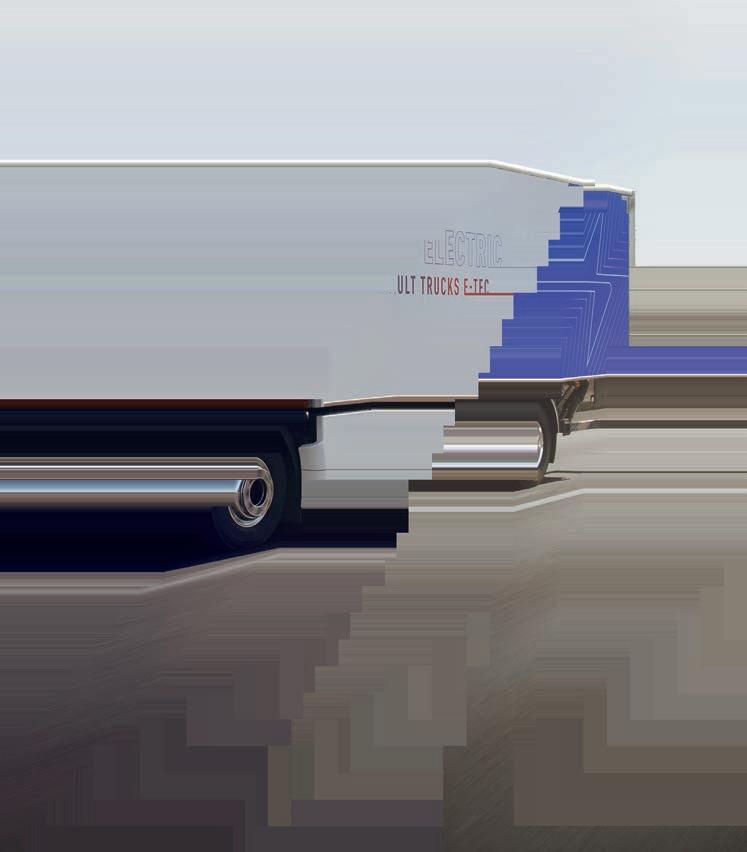
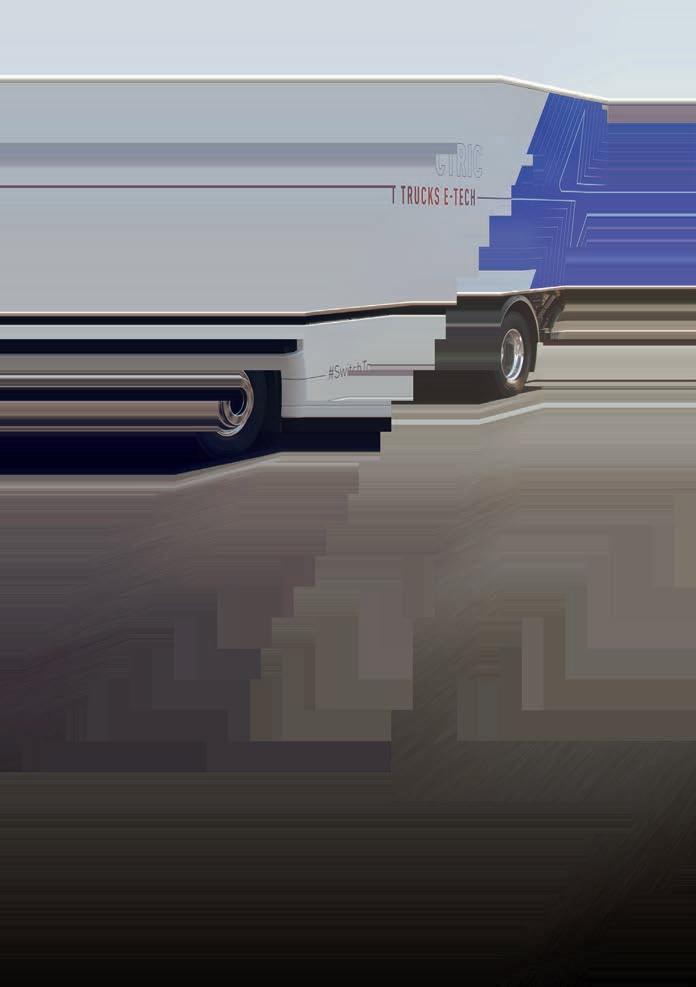

































And while the unpredictability of gas prices last year – which saw some operators forced to stand their gas vehicles – has slowed the pace of Nicholls’ switch to gas trucks, the company’s financial director Darren Sherlock says it has not weakened its resolve.
“If you’re going to be green you have got to believe in it and stand by that commitment,” he explains.
Sherlock adds that if the cost of gas continues to fall this year, the plan to have the majority of its trucks running on gas by 2025 will be back on track.
JLP’s Laney also recalls the strain of those rocketing gas prices, particularly in the summer of 2022 when gas price rises peaked. Up until that point the retailer was saving on average more than £20,000 per truck on operating costs, despite being more expensive to buy and maintain than diesel trucks.
He says: “It was tough but we chose not to lay up any of the fleet. We took the view it would be a short-term spike and always believed the price would stabilise.”
Working the differentials
Laney says the price differential between gas and diesel gave the firm some wriggle room. “Broadly speaking, a kilogramme of gas takes a truck about 10% further than a litre of diesel. So, as long as a kilogramme of gas is no more than 10% more expensive than a litre of diesel, then you’re breaking even on your fuel costs.
He adds: “As of today, gas is cheaper than diesel and has been largely since the beginning of the year. Even last year we almost broke even on gas fuel costs versus spot-market bulk diesel.”
The price differential has been helped by the government’s pledge to maintain the duty discount on gas over diesel until 2032, though this will be reviewed next year.
Westcott firmly believes recent gas price volatility is not enough to dampen demand for what he argues is the only viable show in town.
“There are huge technical challenges to the two most talked about alternative options – EV and hydrogen – in terms of the vehicles and the stations and the challenge of getting energy to the right places, and some of those challenges may be too hard to overcome,” he says.
Even if those challenges are met in the future, Westcott believes there’s still a long way to go before they become affordable and commercially viable for fleets.
Perhaps the last word should go to Laney, who asks
BRIDGING THE GAP: Justin Laney, fleet manager at John Lewis Partnership, reckons using biofuels now is a far better option than waiting until a zero-carbon solution arrives
fleet managers thinking of switching to gas-powered trucks to consider this analogy.
He says: “You’re on a yacht in the middle of an ocean. It’s sprung a leak and you’re sinking. You calculate that you have 24 hours before you go under. You have a handoperated bilge pump. It can’t stop you sinking, but it will buy you 12 hours.
“Your shipmate tells you not to worry; he’s heard a rescue boat is coming, it’ll be there in 18 hours, so you don’t need to bother with the hand pump. What do you do? I’d go with the hand pump, whilst keeping an eye out for the rescue boat.
“It’s analogous with biofuels; they might not be the long-term solution, but they can be applied today and they reduce CO2 levels today, which reduces the challenge we face later.
“In our case, biofuels will save 400,000 tonnes of CO2 by 2030. We could have waited for a zero-carbon solution for long-distance heavy trucks, but we settled, eight years ago, for an 80% reduction.
“Each one of our biomethane-powered tractors saves nearly 100 tonnes of CO2 per year. They have a great business case (despite the recent spike in gas prices) and drivers prefer them.
“My advice? Don't wait for perfect, act now, enjoy the benefits, and keep an eye on what’s next. Oh, and get a different shipmate.”
THE GREENING OF GAS
CNG Fuels calculates that since launching in 2014 it’s removed close to 300,000 tonnes of greenhouse gas emissions from transport.
Philip Fjeld, CNG Fuels CEO, says: “It’s huge. This year alone we’ll probably save north of 100,000 tonnes, and that will only grow as the market expands.”

LEADING BY EXAMPLE: Nicholls Transport is planning an open-access gas refuelling station to encourage other hauliers to make the switch
Bio-LNG is also delivering remarkable results. Gasrec calculates a typical long-haul 6×2 truck running on bio-LNG emits around 90% less NO2 emissions, 99% less particulate matter and 95% less CO2 than a similar diesel truck.
Trucks operating on manure-based biomethane are even cleaner, with Nicholls Transport’s fleet boasting an emissions saving of 191% in the three months to September 2022, according to Zemo Partnership.
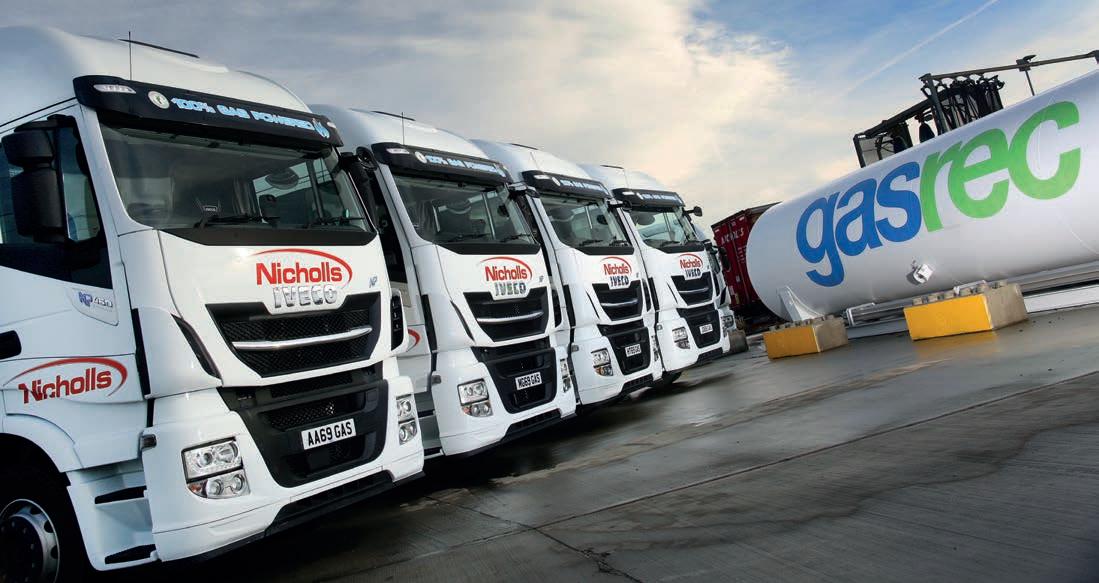
motortransport.co.uk Gas 22 MotorTransport 10.4.23

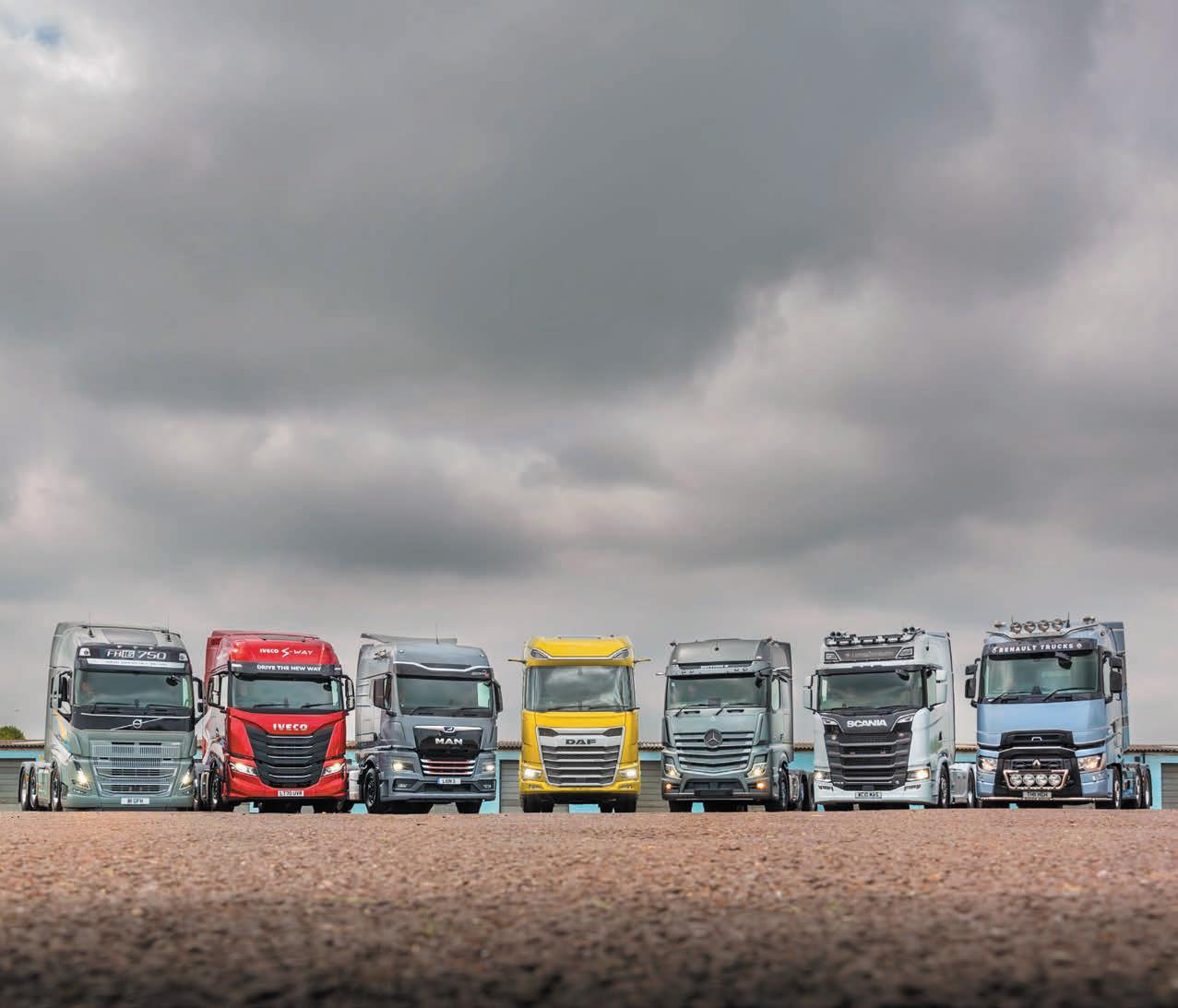
















Staying ahead of the game
The ease with which information can be obtained varies between manufacturers and from model to model, says Pilgrim, adding: “So we’ve invested a lot in the engineering necessary to acquire it.”
Remarks Joe Heidari, fleet and optimisation sales director at telematics group Trakm8: “Some of the manufacturers are kinder than others who, in certain cases, make things extremely difficult. That means we have to reverse engineer, and we’ve found we can extract information from 90% of vehicles.
“We can also show it to any third-party maintenance providers the operator may be using.”
Like its competitors, Bridgestone Mobility Solutions, which owns telematics provider Webfleet, can pull out fault codes and error messages, says strategic partnerships manager, UK and Ireland, James Wyatt. “We can spot things like a stuck EGR valve for instance, which is going to need attention,” he says.
Not surprisingly, it also keeps a weather eye on the onboard tyre pressure monitoring system. It can flag up instances where there is insufficient air in the tyres and trigger an alert if there is a sudden deflation due to a puncture. “80% of truck roadside breakdowns are tyre related,” Wyatt points out.
Seasoned fleet managers take the view that if a thing can go wrong, then at some stage it probably will. Fortunately telematics systems have the ability to warn them if a major fault has arisen on a truck while it is out on the road, enabling prompt action to be taken.
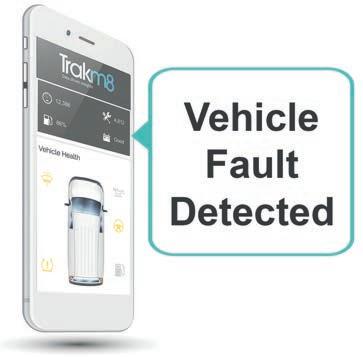
That might involve instructing the driver to nurse the vehicle to a place of safety if they possibly can, so that a mobile technician can deal with the glitch. Telematics packages can also indicate when a fault code has popped up that cannot be classed as an emergency, but does mean the truck should go into a workshop as soon as possible so that the problem can be addressed.
Remote monitoring of this type is a service telematics specialist Geotab can offer for any make of truck, says senior partner account manager, global channel, Josh Pilgrim.

“We can rank faults in order of seriousness,” he observes. Geotab can also spot problems with ancillary equipment such as refrigeration units and tail lifts, again indicating which of them requires prompt action and which can be left until the vehicle gets back to base.
Fault information from a truck comes from its CAN bus system connector. CAN stands for Controller Area Network – the vehicle’s nervous system in effect – while a bus is a communications system that transfers data between components.
“To obtain it we use our IOX-UREADER, a capacitive CAN clamp which connects to the CAN bus and to our GO9 device and gives us access to the J1939 protocols,” Pilgrim says. J1939 denotes a set of standards drawn up by the Society of Automotive Engineers that define how electronic control units communicate via the CAN bus in trucks, buses and coaches.
DATA DIGGING: Trakm8 can extract information from 90% of vehicles
Defining common standards
Truck manufacturers have invested heavily in their own telematics packages, but they are designed primarily with their own products in mind rather than for universal applications. Vehicle builders have nevertheless worked together over the past 20-plus years to define common standards through the fleet management system (FMS) interface under the auspices of ACEA, the European Automobile Manufacturers’ Association.
The FMS interface can divulge everything from whether the cruise control has been used to how much fuel has been consumed. It can also give access to diagnostic data and indicate whether preventive maintenance is required.
“The data available from it is limited though,” contends Geotab vice president, Europe, OEM, global channel, Christoph Ludewig. “Remember that the manufacturers are competitors, and always want to have some kind of competitive advantage.”
Heidari adds: “They know that if you come to rely on their system then that keeps you tied into them.”
An FMS output remains an option with most manufacturers rather than a standard feature, although aftermarket interfaces that convert raw CAN bus data to the FMS standard are available.
The information individual manufacturers can extract from their own products is invariably going to be more detailed than anything that can be obtained from a thirdparty telematics provider. However, having access to such detail is not essential to the efficient day-to-day running of a fleet, says Wyatt.
motortransport.co.uk Telematics 24 MotorTransport 10.4.23
Modern trucks produce a slew of data, which can be used to aid maintenance, collision management and future planning. Steve Banner investigates the possibilities
➜ 26
Photo: Antonio Diaz

“They can supply 10,000 bits of information, but we’re not trying to dig out complex data,” he comments. “All we’re trying to do is supply the data that most operators actually want.”
That is increasingly likely to include the level of charge an electric truck has in its batteries and how soon it will have to be charged.
“We’ve just started to provide data from trailer electronic braking systems,” he adds. Doing so requires the trailer to be fitted with its own black box.
Managing collisions
Far more serious than a flat tyre or a lack of AdBlue is a collision with another vehicle. VisionTrack can alert a fleet’s management team if one of its trucks is involved in a collision so that the emergency services can be summoned or arrangements made for the damaged vehicle to be removed if necessary.
“It also helps to mitigate any claims made against your company,” points out commercial director Richard Lane. “If your driver is at fault and a car has been damaged then you can arrange for it to be repaired and get a hire car out to the owner.”
If you are unaware of what has happened and so cannot act quickly, then it is likely that you will end up dealing with an accident management company representing the injured party. “If that happens then the repair cost will be higher, and so will the car rental bill,” he says.
Collecting large quantities of data and interpreting it can be a major challenge for businesses such as Fraikin, which manages over 58,000 vans and trucks. To make life easier it has enlisted the help of Samsara, which captures data on everything from diagnostic fault codes to distracted driving and centralises it on a cloud-based platform.

Doing so makes it easier to, for example, compare the total cost of ownership of each vehicle on the fleet, and plan future acquisitions accordingly. “It means we can offer customers cost savings,” says newly appointed UK technology solutions manager Regan Greeff. “More of Fraikin’s customers are beginning to embrace what connected technology has to offer,” he observes.
Over-the-air updates
Truck makers can deliver over-the-air fixes without any need for the vehicle to visit a workshop if all that is required to eliminate a snag is a software tweak or update. This
MAN TEAMS UP WITH MICROLISE
In the UK, MAN has worked with telematics group Microlise in recent years to deliver a remote fault diagnosis service to support operators under the MAN Check banner. “It’s been available on all of our new vehicles since late 2017, it’s linked specifically to them and all our dealer workshops can access it,” says Ajaz Khan, the manufacturer’s UK customer service management Up Time Principle (UTP) support centre manager.
If a warning light comes on and the driver rings the transport manager to report it, then an MAN dealer with remote access to the vehicle can be alerted. Its technicians can then determine if it is a minor issue that can wait until the truck next comes in for a service, or if it requires immediate attention.
If the haulage company concerned has a workshop where it
facility is provided by Iveco, among others.
Iveco Over the Air Update, which is part of the Iveco On package, is available on models equipped with a connectivity box if the operator is an Iveco On registered user and the vehicle is covered by the system. When the driver receives a notification that an update is available, and provided the van or truck is parked, it can be downloaded and installed using either a button on the onboard infotainment system or an icon on the Easy Way app. Says Iveco brand president Thomas Hilse: “Our customers can ensure that their vehicles are always up to date, protected and perform at their best without wasting any time in the workshop.”
Independent telematics companies are usually unable to provide this sort of service in Europe, where truck makers tend to be vertically integrated and organise such fixes themselves, but North America offers greater opportunities in this area.

In the USA, Geotab will soon start to provide over-theair updates for Cummins, which supplies engines to several manufacturers of light, medium and heavy commercial vehicles. Updates can be delivered in under five minutes, claims Geotab, which means less downtime.
Comments Jose Samperio, executive director, North America On-Highway at Cummins: “This is a great next step in our growing relationship with Geotab to deliver the latest technology and capabilities to our common customers. It offers scalability and convenience, allowing fleets the option to automatically deploy updates to all their vehicles in an efficient manner.”
carries out its own service and repair work, then it can look at the data on request. Customers do not ordinarily have direct access to MAN Check, although that is going to change, says Khan.
“We’re in discussions with Microlise about providing a customerfacing version of the system but we don’t have a timeframe for it,” he comments.
The arrangement with Microlise makes the UK something of an outlier in the MAN firmament. It looks likely to be superseded eventually, as the services delivered through the manufacturer’s own wide-ranging cloud-based RIO platform gradually expand. RIO telematics boxes are fitted as standard to all new MAN vehicles and can be retrofitted to certain models.
At present RIO embraces everything from tracking and the remote inspection of tachograph data to driving style and how it can be improved, and everything can be accessed through an internet browser. RIO can deliver over-the-air software upgrades as well. The ServiceCare element monitors areas including the health of individual components and how long they are likely to last before they need replacing, and triggers support if a fault results in a breakdown. It has an FMS gateway which should make it easier for operators to collate data from their MAN trucks with data from other makes of vehicle.
“We’ll be introducing it in the UK during the second quarter of this year,” says Khan. “The idea is that it will ultimately replace MAN Check.”
motortransport.co.uk Telematics 26 MotorTransport 10.4.23
UNDER PRESSURE:
Webfleet’s telematics system triggers an alert if there is a sudden tyre deflation




















